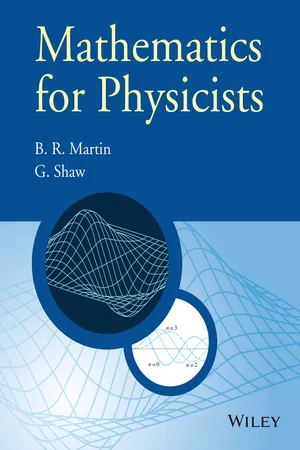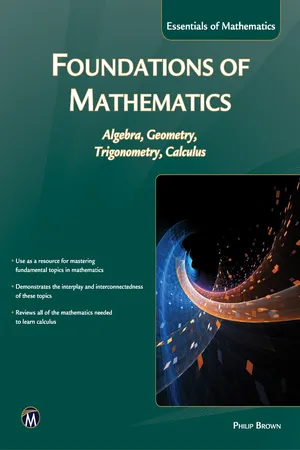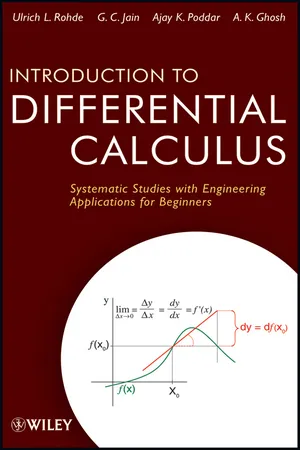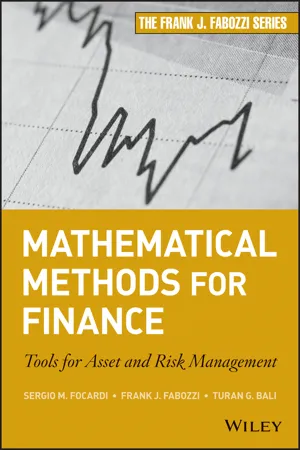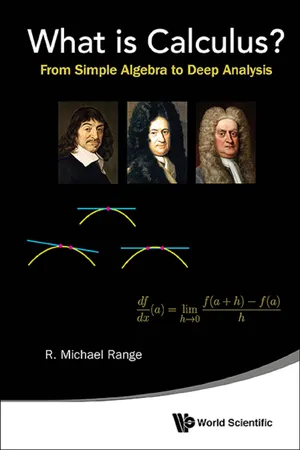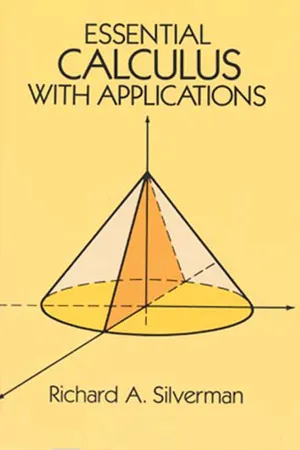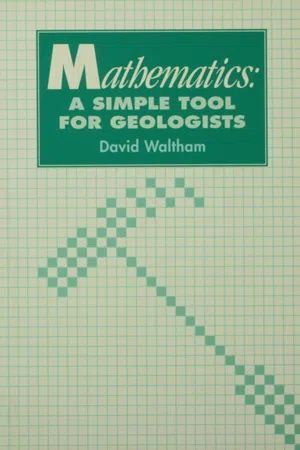Physics
Differential Calculus
Differential calculus is a branch of mathematics that deals with the study of rates at which quantities change. It involves the concept of derivatives, which represent the rate of change of a function with respect to its independent variable. In physics, differential calculus is used to analyze motion, rates of change, and gradients of physical quantities.
Written by Perlego with AI-assistance
Related key terms
9 Key excerpts on "Differential Calculus"
- eBook - ePub
- Huw Fox, William Bolton(Authors)
- 2002(Publication Date)
- Butterworth-Heinemann(Publisher)
4Calculus
SummaryCalculus is concerned with two basic operations, differentiation and integration, and is a tool used by engineers to determine such quantities as rates of change and areas; in fact, calculus is the mathematical ‘backbone’ for dealing with problems where variables change with time or some other reference variable and a basic understanding of calculus is essential for further study and the development of confidence in solving practical engineering problems. This will become evident in the next chapter where physical systems will be modelled and the use of ‘rates of change’ equations (called differential equations) will allow the physical system to be represented, an analysis made and a solution formed under defined conditions. This chapter is an introduction to the techniques of calculus and a consideration of some of their engineering applications. The topic continues in the next chapter with a discussion of the use of differential equations to represent physical systems and their solution for various inputs.Objectives By the end of this chapter, the reader should be able to:• understand the concept of a limit and its significance in rate of change relationships; • use calculus notation for describing a rate of change (differentiation) and understand the significance of the operation; • solve engineering problems involving rates of change; • understand what is involved in the calculus operation of integration; • solve engineering problems involving integration.4.1 Differentiation
Suppose we have an equation describing how the distance covered in a straight line by a moving object varies with time. We could plot a graph of displacement against time and determine the velocity at some instant as the gradient of the tangent to the curve at that instant. By taking a number of such gradient measurements we could then determine how the velocity varied with time. However, differentiation is a mathematical technique which can be used to determine the rate at which functions change and hence the gradients, this thus enabling the velocity to be obtained from the equation without drawing the graph and tangents. We could also, for example, describe how the deflection of an initially horizontal beam in the y -direction alters with distance along the beam in the x - eBook - ePub
- Brian R. Martin, Graham Shaw(Authors)
- 2015(Publication Date)
- Wiley(Publisher)
3 Differential CalculusThe introduction of the infinitesimal calculus, independently by Newton and Leibnitz in the late seventeenth century, was one of the most important events not only in the history of mathematics but also of physics, where it has been an indispensable tool ever since.In this chapter and the one that follows, we introduce the formalism in the context of functions of a single variable. We start by considering differentiation, the calculation of the instantaneous rate of change of a function as its argument changes. So, for example, given a function x(t), which specifies the position of a particle moving in one dimension as a function of time t, the operation of differentiation yields a function representing the velocity. The inverse operation, called integration, will be discussed in Chapter 4 and enables the position x(t) to be deduced from and the value of x at some time, for example t = 0. These two operations – differentiation and integration – play a crucial role in understanding not only mechanics, but the whole of physical science. Both rest on ideas of limits and continuity, to which we now turn.3.1 Limits and continuity
In previous chapters, we have used the ideas of limits and continuity in simple cases where their meaning is obvious. In this section we shall define them more precisely, before showing how they lead naturally to the idea of differentiation in Section 3.2 - eBook - ePub
Foundations of Mathematics
Algebra, Geometry, Trigonometry and Calculus
- Philip Brown(Author)
- 2016(Publication Date)
- Mercury Learning and Information(Publisher)
8Differential Calculus
8.1INTRODUCTION
Differential Calculus, the topic of this chapter, is, in large part, the legacy of Sir Isaac Newton. In his gigantic publication, The Principia Mathematica, Newton introduced the mathematics of calculus and applied it to the scientific study of the orbits of the planets around the sun. Thus, he not only revolutionized science but also created the mathematics he needed in order to do so.This chapter deals with the derivatives of functions. While we study a function abstractly as mathematical object, in real-world applications it is a representation of motion (in a very general sense). In Differential Calculus, the notion of the derivative of a function, and the corresponding geometric notion of the slope of a tangent line to the graph of the function, relates to the idea of “instantaneous motion.” As we will begin to explain, in this chapter, the knowledge gained about the “instantaneous motion” of a function enables us to investigate and discover important properties of the function; for example, where the peaks of a function occur, or the approximate behavior of a function near any particular point in the domain of the function.In this chapter we will give the definition of the derivative, introduce the notion of a derivative function and present the rules (the power rule, sum rule, product rule, quotient rule and the chain rule) for computing it, and apply the definition and rules to compute the derivatives of the standard functions (such as polynomial, rational, root, trigonometric, exponential and logarithmic, inverse trig), and vector functions.In section 8.2 , the definition of the derivative is introduced in four parts: in section 8.2.1 , the notion of a graph “leveling out” at the origin and its mathematical statement in terms of a limit is an intuitive and mathematically simplest starting point. In section 8.2.2 , the tangent line to a graph at the origin is introduced as the best approximating line by means of a graphical example. This is interpreted in section 8.2.3 , as it is stated that the difference function (graph minus tangent line) “levels out” at the origin. Consequently, the limit formula from section 8.2.1 can be applied to derive the slope of the tangent line at the origin. Finally, in section 8.2.4 - eBook - ePub
Introduction to Differential Calculus
Systematic Studies with Engineering Applications for Beginners
- Ulrich L. Rohde, G. C. Jain, Ajay K. Poddar, A. K. Ghosh(Authors)
- 2012(Publication Date)
- Wiley(Publisher)
actual rate(s) of change (or instantaneous rate(s) of change ) of varying quantities .To emphasize the importance of actual speed , imagine the situation when the car strikes a tree. Here, what matters is the actual speed of the car at the time of strike . Similarly, as a bullet travels through air, its average velocity may be around 2000 km/h (i.e., 555 m/s, approximately), but what counts when it strikes a person is the actual velocity at the instant of striking .If it is 2 km/h (i.e., 0.55 m/s), the bullet will drop (without causing any harm), but if it is 555 m/s, the person will drop.The speedometer of a vehicle indicates its actual speed at each instant (to keep the driver alert, so that he could use necessary controls to avoid accidents). Again, we are interested neither in the speeds of vehicles meeting with accidents nor in the velocities of bullets striking individuals. However, our interest lies in being able to compute the actual rate(s) of change of varying quantities because there are many scientific problems that require the use of instantaneous speed.4Consider a function f (in the form of a formula ) defining the way in which the quantity y [= f (x )] changes with x . Then, the Differential Calculus helps in computing a new function, denoted by f ′ (x ), which describes the actual rate of change in f(x) with respect to x . The new function f ′ (x ) is obtained from the given function f (x ), through a definite procedure, to be discussed shortly.5In practice, the speed of a car (or any other vehicle) is always varying, reasonably close to the desired average speed. For our purpose, let us assume that a car moves in a straight line according to the formula y = f (x ) = 3x 2 , connecting the distance traveled with time (y in meters, x in seconds). Note that, with the passage of time (i.e., for higher values of x ) the car can attain a very high speed, and our interest lies in computing actual speed of the car, at any instant of time. In fact, the actual speed (or instantaneous speed) of the car can be read from the speedometer or it can be obtained by substituting the value of the instant “x ” in the formula of the derivative function to be obtained from the given function f (x ).6 - eBook - ePub
Mathematical Methods for Finance
Tools for Asset and Risk Management
- Sergio M. Focardi, Frank J. Fabozzi, Turan G. Bali(Authors)
- 2013(Publication Date)
- Wiley(Publisher)
INTRODUCTION- Financial applications of Differential Calculus.
- Duration and convexity of bonds.
Invented in the seventeenth century independently by the British physicist Isaac Newton and the German philosopher G. W. Leibnitz, calculus—or infinitesimal calculus to use its first name—was a major mathematical breakthrough that made possible the modern development of the physical sciences. Calculus introduced two key ideas:- The concept of instantaneous rate of change.
- A framework and rules for linking together quantities and their instantaneous rates of change.
Suppose that a quantity such as the price of a financial instrument varies as a function of time. Given a finite interval, the rate of change of that quantity is the ratio between the amount of change and the length of the time interval. Graphically, the rate of change is the steepness of the straight line that approximates the given curve.1 In general, the rate of change will vary as a function of the length of the time interval.What happens when the length of the time interval gets smaller and smaller? Calculus made the concept of infinitely small quantities precise with the notion of limit . If the rate of change can get arbitrarily close to a definite number by making the time interval sufficiently small, that number is the instantaneous rate of change. The instantaneous rate of change is the limit of the rate of change when the length of the interval gets infinitely small. This limit is referred to as the derivative of a function , or simply, derivative . Graphically, the derivative is the steepness of the tangent to a curve.Starting from this definition and with the help of a number of rules for computing a derivative, it was shown that the instantaneous rate of change of a number of functions—such as polynomials, exponentials, logarithms, and many more—can be explicitly computed as a closed formula. For example, the rate of change of a polynomial is another polynomial of a lower degree. - eBook - ePub
What is Calculus?
From Simple Algebra to Deep Analysis
- R Michael Range(Author)
- 2015(Publication Date)
- WSPC(Publisher)
Prelude to Calculus1 Introduction
Differential Calculus was developed in the 17th century in order to solve fundamental problems involving motion with variable velocity and the equivalent geometric problem of finding tangents to general curves. Tangents to simple special curves were already considered in antiquity, but their construction for general curves became possible only after the introduction of coordinates opened the door to using algebraic and analytic tools in the description of geometric properties. Similarly, motion subject to forces and acceleration could only be fully understood once the most creative minds of the 17th century were able to apply the new mathematical methods to real world phenomena, and expand their reach to new levels.In this Prelude to Calculus we discuss tangents, their relationship to motion with variable speed, and all the standard rules of “differentiation” by means of elementary algebraic techniques familiar from high school algebra, without ever mentioning limits or other more advanced concepts. While the discussion is limited to the familiar algebraic functions (i.e., polynomial, rational, and root functions, and standard combinations of them), the simple proofs are presented in a form that will later readily generalize to exponential, trigonometric, and other more general functions that will be considered in the main part of this book. In the final section of this Prelude we attempt to use analogous methods for a simple exponential function, and we quickly recognize that some deeper new ideas are needed in order to deal with surprising new phenomena. This prepares the stage for the main topic of this book, that is, an introduction to the analytic - eBook - ePub
- Auguste Comte(Author)
- 2012(Publication Date)
- Perlego(Publisher)
We must, however, also admit that the conceptions which are habitually considered in the method of variations being, by their nature, more indirect, more general, and especially more abstract than all others, the employment of such a method exacts necessarily and continuously the highest known degree of intellectual exertion, in order never to lose sight of the precise object of the investigation, in following reasonings which offer to the mind such uncertain resting-places, and in which signs are of scarcely any assistance. We must undoubtedly attribute in a great degree to this difficulty the little real use which geometers, with the exception of Lagrange, have as yet made of such an admirable conception.CHAPTER VI.
THE CALCULUS OF FINITE DIFFERENCES.
The different fundamental considerations indicated in the five preceding chapters constitute, in reality, all the essential bases of a complete exposition of mathematical analysis, regarded in the philosophical point of view. Nevertheless, in order not to neglect any truly important general conception relating to this analysis, I think that I should here very summarily explain the veritable character of a kind of calculus which is very extended, and which, though at bottom it really belongs to ordinary analysis, is still regarded as being of an essentially distinct nature. I refer to the Calculus of Finite Differences, which will be the special subject of this chapter.Its general Character. This calculus, created by Taylor, in his celebrated work entitled Methodus Incrementorum, consists essentially in the consideration of the finite increments which functions receive as a consequence of analogous increments on the part of the corresponding variables. These increments or differences, which take the characteristic Δ, to distinguish them from differentials, or infinitely small increments, may be in their turn regarded as new functions, and become the subject of a second similar consideration, and so on; from which results the notion of differences of various successive orders, analogous, at least in appearance, to the consecutive orders of differentials. Such a calculus evidently presents, like the calculus of indirect functions, two general classes of questions:1°. To determine the successive differences of all the various analytical functions of one or more variables, as the result of a definite manner of increase of the independent variables, which are generally supposed to augment in arithmetical progression.2°. Reciprocally, to start from these differences, or, more generally, from any equations established between them, and go back to the primitive functions themselves, or to their corresponding relations. - eBook - ePub
- Richard A. Silverman(Author)
- 2013(Publication Date)
- Dover Publications(Publisher)
Chapter 2 Differential Calculus2.1 FUNCTIONS
2.11. Constants and variables. The quantities encountered in mathematics fall into two broad categories, namely “fixed quantities,” called constants , and “changing quantities,” called variables . A constant “takes only one value” in the course of a given problem, while a variable “takes two or more values” in the course of one and the same problem.For example, let L be the straight line with slope m and y -intercept b . Then, according to Sec. 1.9 , L has the equationHere m and b are constants characterizing the given line L , while x and y are variables, namely the abscissa and ordinate of a point which is free to change its position along L .As another example, suppose a stone is dropped from a high tower. Let s be the distance fallen by the stone and t the elapsed time after dropping the stone. Then, according to elementary physics, s and t are variables which are related, at least for a while, by the formulawhere g is a constant known as the “acceleration due to gravity.” To a good approximation, this formula becomesif s is measured in feet and t in seconds.2.12. Related variables and the function concepta. A great many problems arising in mathematics and its applications involve related variables . This means that there are at least two relevant variables, and the value of one of them depends on the value of the other, or on the values of the others if there are more than two. For example, the position of a spy satellite depends on the elapsed time since launching, the cost of producing a commodity depends on the quantity produced, the area of a rectangle depends on both its length and its width, and so on.Actually, the situation we have in mind is where knowledge of the values of all but one of the variables uniquely determines the value of the remaining variable, in a crucial sense to be spelled out in a moment (Sec. 2.12b ). The variables whose values are chosen in advance are called independent variables , and the remaining variable, whose value is determined by the values of the other variables, is called the dependent variable . The “rule” or “procedure” leading from the values of the independent variables to the value of the dependent variable, regardless of how this is accomplished, is called a function . We then say that the dependent variable “is a function of” the independent variables. The independent variables are often called the arguments - eBook - ePub
- D. Waltham(Author)
- 2013(Publication Date)
- Routledge(Publisher)
8 Differential Calculus8.1 Introduction
Calculus, discovered in the seventeenth century by Newton and independently by Leibniz, is where advanced mathematics is usually assumed to begin. Despite this, the mathematical manipulations used in elementary calculus are very simple to apply. The real difficulty with calculus is not in 'How is it done?' but rather in 'How is it used for solving a particular problem?' A further difficulty is the, at first sight, strange new notation that is required. The mathematical expressions used in calculus are quite different from those you will have encountered previously and this is a significant barrier to understanding. In other words, calculus calculations are easy to do once you understand their strange appearance but this knowledge is of limited use until you have a good grasp of how to use mathematics more generally for solving real problems. Hopefully, the preceding chapters will have improved your ability to apply simple mathematics. In this chapter, and the next, I shall introduce you to the techniques and notation of calculus and show a few examples of ways to use these techniques. First, however, I should discuss what calculus is for.8.2 Rates of Geological Processes
Geology is a process-centred subject. Virtually all geological observations can, and should, be explained by the interaction of various physical, chemical or biological processes. Increasing burial, for example, is a process which has the effect of compressing, heating and chemically altering a sediment. Biological activity such as burrowing is a process which has the effect of mixing the uppermost metre or so of sediment. Convergence of two plate tectonic plates is a process which can lead to the formation of mountain chains. The point that I wish to make is that all of these processes, and their results, occur at a certain rate. Burial, for example, might occur at a rate of 1 m per 1000 years or so. Biological mixing could lead to, say, 10% of the upper layer being reworked every year. Plate convergence rates are generally several centimetres per year. These are all examples of rates expressed in terms of the amount of change produced in a certain amount of time, e.g. 1 m of extra sediment in 1000 years, 10% mixing in one year or 3 cm of plate convergence in one year.
Learn about this page
Index pages curate the most relevant extracts from our library of academic textbooks. They’ve been created using an in-house natural language model (NLM), each adding context and meaning to key research topics.

